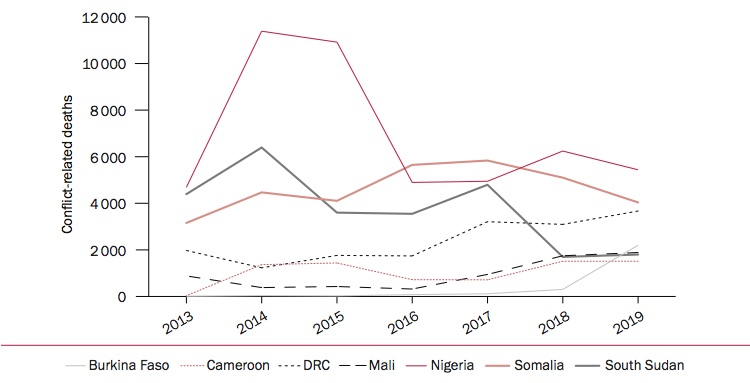7. Armed conflict and peace processes in sub-Saharan Africa
Overview [PDF]
I. Key general developments in the region, Ian Davis [PDF]
II. Armed conflict and peace processes in the Sahel and Lake Chad region, Ian Davis [PDF]
III. Armed conflict and peace processes in Central Africa, Ian Davis [PDF]
IV. Armed conflict and peace processes in the Horn of Africa, Ian Davis [PDF]
There were at least 15 countries with active armed conflicts in sub-Saharan Africa in 2019: Burkina Faso, Burundi, Cameroon, the Central African Republic (CAR), Chad, the Democratic Republic of the Congo (DRC), Ethiopia, Kenya, Mali, Mozambique, Niger, Nigeria, Somalia, South Sudan and Sudan. Eight were low-intensity, subnational armed conflicts, and seven were high-intensity armed conflicts (Nigeria, Somalia, the DRC, Burkina Faso, Mali, South Sudan and Cameroon). Almost all the armed conflicts were internationalized, including as a result of state actors (whether directly or through proxies) and the transnational activities of violent Islamist groups, other armed groups and criminal networks. The conflict dynamics and ethnic and religious tensions were often rooted in a combination of state weakness, corruption, ineffective delivery of basic services, competition over natural resources, inequality and a sense of marginal-ization. Two other cross-cutting issues continued to shape regional security: the ongoing internationalization of counter-terrorism activities, and the growing impact of climate change—with water scarcity being a particularly serious challenge.

Peace operations
There were 20 multilateral peace oper-ations active in sub-Saharan Africa in 2019 (two fewer than in 2018), including several large-scale operations in countries that were experiencing armed conflict such as the CAR, the DRC, Mali, Somalia and South Sudan. The number of personnel deployed in the region (97 519 on 31 December 2019) decreased for the fourth year in a row and reached the lowest point since 2012.
A worsening crisis in the Sahel and Lake Chad region
The armed conflicts in Burkina Faso, Cameroon, Chad, Mali, Niger and Nigeria all worsened in 2019. The security challenges are linked to the rise of violent extremism and the proliferation of armed non-state groups, such as Boko Haram, which has spread from Nigeria across the Lake Chad region. The violent extremist groups are interwoven with rural insurgent groups, feeding off intercommunal tensions and exploiting grievances of marginalized communities.
Armed conflict fatalities increased sig-nifi-cantly in Burkina Faso in 2019 due to a broadening of three inter-connected layers of conflict: the government’s conflict with heavily armed Islamist groups, clashes between armed ethnic and Islamist groups, and inter-communal violence.
Central Africa
There were two main challenges in Central Africa in 2019: (a) the implementation of a new peace agreement in the CAR between the government and armed groups, and (b) a period of political transition in the DRC, which was accompanied by an increase in insecurity and political violence in the eastern provinces and an ongoing health emergency from measles and Ebola outbreaks.